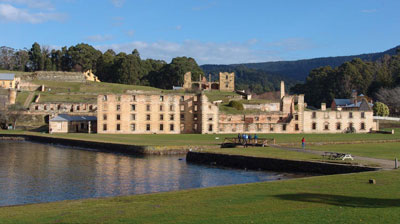
Port Arthur penal settlement ruins
Relics of the convict era
By the end of the 18th century, British prisons were seriously overcrowded. The government’s solution was to lock convicts in hulks - old ships anchored in river estuaries. When the hulks were full the government decided to get rid of the convicts to the new colony of New South Wales (Australia), where they could be used as cheap labour to build the new colony.
Van Diemen's Land (the early name for Tasmania) was soon seen as a suitable place to send convicts and many convict stations and settlements were established there, particularly in the south in and around Hobart. This settlement, of which port arthur was the most famous, quickly earned a reputation for being the most feared, as not only was the treatment convicts harsh, they were isolated from the rest of the world. Male convicts, often in chains, tunnelled new coal mines, cut timber in the thick forests, quarried stone, built roads, made bricks, built ships.
Southern Tasmania has more relics of the convict era than any other location in the world, and the most distant from Hobart are around an hour's drive away from the city. The penal settlement at Port Arthur is the most famous, but there are many others scattered through the countryside. More >>

Defending Hobart
The Hobart coastal defences are a network of now defunct coastal batteries, some of which are inter-linked with tunnels, that were designed and built by British colonial authorities in the nineteenth century to protect the city of Hobart, Tasmania, from attack by enemy warships.
During the nineteenth century, the port of Hobart Town was a vital re-supply stop for international shipping and trade, and therefore a major freight hub for the British Empire. As such, it was considered vital that the colony be protected. In all, between 1804 and 1942 there were 12 permanent defensive positions constructed in the Hobart region. More >>
|
Hobart's Architecture
Hobart began its early life as a penal colony in 1803, making it the 2nd oldest city in Australia. In part, because of its isolation by not being on the mainland, Hobart never experienced the same degree of growth enjoyed by the other state capitals. As a result, their has been less of a need to bulldoze its older building to make way for bigger, more modern buildings.

The city has therefore retained much of its colonial character, and what growth their has been did not destroy too much of its architectural heritage as has happened in many of the mainland capital cities.
All the popular architectural styles of the 19th and 20th centuries, from early colonial Georgian through to the International style, are therefore represented in Hobart's architectural landscape. More >>

Hobart's Lost Island
Hobart's Hunter Street is not only the site where Hobart had its beginnings, but the location of a tiny rocky island which once stood out from the main shore of Sullivans Cove, and was given the name Hunter's Island.
Founded on convict labour, it was here that the first successful attempt to establish a permanent European colony in Van Diemen's Land was made. From these early beginnings, the Hunter Street site evolved into Tasmania's principal trading port in the mid-nineteenth century. The growth of the port was fundamental to the growth of the city of Hobart and it was here where large-scale commercial and industrial development took place, coexisting with residential life. So what happened to Hunter's Island? >>>
Hobart's birthplace

The European settlement of Tasmania had a false start, and it happened at Risdon Cove in suburban Hobart in 1803 on the eastern bank of the River Derwent. Lieutenant John Bowen was sent to establish a settlement in Van Diemen's Land (Tasmania) with 48 free settlers. The Lady Nelson anchored at Risdon in September 1803; it was followed five days later by the whaler Albion with Lt. Bowen on board. More >>
|